2022 TOYOTA COROLLA warning
[x] Cancel search: warningPage 287 of 678

285
4
4-5. Using the driving support systems
Driving
■The Parking Support Brake func- tion (static object) will operate
when
The function will operate when the PKSB OFF indicator is not illuminated or
flashing ( P.81, 83) and all of the fol-
lowing conditions are met:
●Engine output restriction control
• The Parking Support Brake is ena- bled.
• The vehicle speed is approximately 15
km/h (9 mph) or less. • There is a static object in the traveling
direction of the vehicle and approxi-
mately 2 to 4 m (6 to 13 ft.) away. • The Parking Support Brake deter-
mines that a stronger-than-normal
brake operation is necessary to avoid a collision.
●Brake control• Engine output restriction control is
operating
• The Parking Support Brake deter- mines that an immediate brake opera-
tion is necessary to avoid a collision.
■The Parking Support Brake func-
tion (static objects) will stop oper- ating when
The function will stop operating if any of
the following conditions are met:
●Engine output restriction control
• The Parking Support Brake is disa-
bled. • The system determines that the colli-
sion has become avoidable with nor-
mal brake operation. • The static object is no longer approxi-
mately 2 to 4 m (6 to 13 ft.) away from
the vehicle or in the traveling direction of the vehicle.
●Brake control• The Parking Support Brake is disa-
bled.
• Approximately 2 seconds have elapsed since the vehicle was
stopped by brake control.
• The brake pedal is depressed after the vehicle is stopped by brake con-
trol.
• The static object is no longer approxi-
mately 2 to 4 m (6 to 13 ft.) away from the vehicle or in the traveling direction
of the vehicle.
■Detection range of the Parking Sup-
port Brake function (static objects)
The detection range of the Parking Sup-
port Brake function (static objects) dif-
fers from the detection range of the Toyota parking assist-sensor. ( P.268)
Therefore, even if the Toyota parking
assist-sensor detects an object and pro- vides a warning, the Parking Support
Brake function (static objects) may not
start operating.
■Situations in which the system may not operate properly
P. 2 6 6
■Situations in which the system may
operate even if there is no possibil- ity of a collision
P. 2 6 7
Page 315 of 678

313
4
4-5. Using the driving support systems
Driving
WA R N I N G
●Make sure to observe the following
precautions regarding the exit par-
allel parking assist mode. Exit parallel parking assist mode is
a function used when departing
from a parallel parking spot. How- ever, this function may not be usa-
ble if obstacles or people are
detected in front of the vehicle. Only
use this function when departing from a parallel parking spot. In the
event that the steering control oper-
ates, either turn the system off using the S-IPA switch or operate
the steering wheel to stop the con-
trol.
●If exit parallel parking assist mode
is mistakenly used in the following situations, the vehicle may make
contact with an obstacle.
The departure function is operated in a direction where an obstacle is
present, but the obstacle is not
detected by the side sensors (situa- tions such as when the vehicle is
directly beside a pole).
●Observe the following precautions,
as the sensors may stop function-
ing properly which may lead to an accident.
• Do not subject the sensor to strong
shocks by hitting it, etc. The sen- sors may not function properly.
• When using a high-pressure washer to wash the vehicle, do not
spray water directly on the sensors.
Equipment may not function prop- erly if subjected to an impact from
strong water pressure. If the vehicle
bumper strikes something, equip- ment may not operate properly due
to a sensor malfunction. Have the
vehicle inspected at any authorized Toyota retailer or Toyota authorized
repairer, or any reliable repairer.
●In the following situations, the sen- sors may not operate normally and
may lead to an accident. Drive
carefully.
• Obstacles cannot be detected in
the side areas until a scan of the
side areas is completed. (P.265)
• Even after the scan of the side
areas is completed, obstacles such as other vehicles, people or ani-
mals that approach from the sides
cannot be detected.
• The sensor is frozen (if it thaws, the
system returns to normal). A warning message may display at
particularly low temperatures due to
the sensor freezing and it may not detect parked vehicles.
• The sensor is blocked by some- one’s hand.
• The vehicle is tilted a large amount.
• The temperature is extremely hot or
cold.
• The vehicle is driven on undulating
roads, slopes, gravel roads, in areas with tall grass, etc.
• An ultrasonic wave source is nearby, such as the horn or sensors
of another vehicle, a motorcycle
engine or the air brake of a large vehicle.
• Heavy rain or a water strikes the vehicle.
• The angle of the sensor may be deviated when assist control starts
even if there is a parked vehicle in
the target parking spot. Have the
vehicle inspected at any authorized Toyota retailer or Toyota authorized
repairer, or any reliable repairer.
• Do not install any accessories
within the sensor detection range.
Page 319 of 678
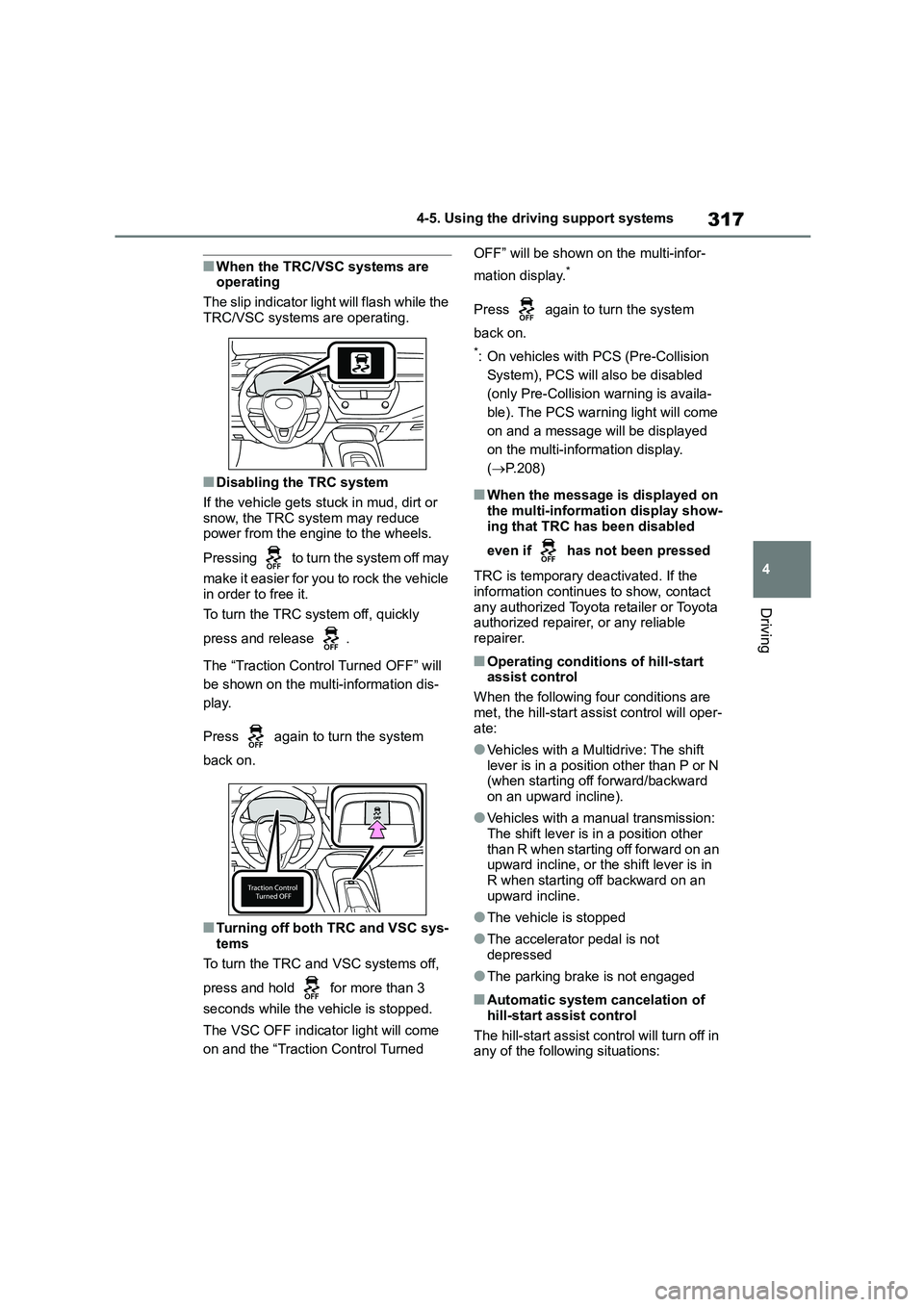
317
4
4-5. Using the driving support systems
Driving
■When the TRC/VSC systems are operating
The slip indicator light will flash while the
TRC/VSC systems are operating.
■Disabling the TRC system
If the vehicle gets stuck in mud, dirt or snow, the TRC system may reduce
power from the engine to the wheels.
Pressing to turn the system off may
make it easier for you to rock the vehicle
in order to free it.
To turn the TRC system off, quickly
press and release .
The “Traction Control Turned OFF” will
be shown on the multi-information dis-
play.
Press again to turn the system
back on.
■Turning off both TRC and VSC sys-
tems
To turn the TRC and VSC systems off,
press and hold for more than 3
seconds while the vehicle is stopped.
The VSC OFF indicator light will come
on and the “Traction Control Turned
OFF” will be shown on the multi-infor-
mation display.*
Press again to turn the system
back on.
*: On vehicles with PCS (Pre-Collision
System), PCS will also be disabled
(only Pre-Collision warning is availa-
ble). The PCS warning light will come
on and a message will be displayed
on the multi-information display.
( P.208)
■When the message is displayed on
the multi-information display show-
ing that TRC has been disabled
even if has not been pressed
TRC is temporary deactivated. If the
information continues to show, contact any authorized Toyota retailer or Toyota
authorized repairer, or any reliable
repairer.
■Operating conditions of hill-start assist control
When the following four conditions are
met, the hill-start assist control will oper- ate:
●Vehicles with a Multidrive: The shift lever is in a position other than P or N
(when starting off forward/backward
on an upward incline).
●Vehicles with a manual transmission:
The shift lever is in a position other than R when starting off forward on an
upward incline, or the shift lever is in
R when starting off backward on an upward incline.
●The vehicle is stopped
●The accelerator pedal is not
depressed
●The parking brake is not engaged
■Automatic system cancelation of
hill-start assist control
The hill-start assist control will turn off in any of the following situations:
Page 323 of 678
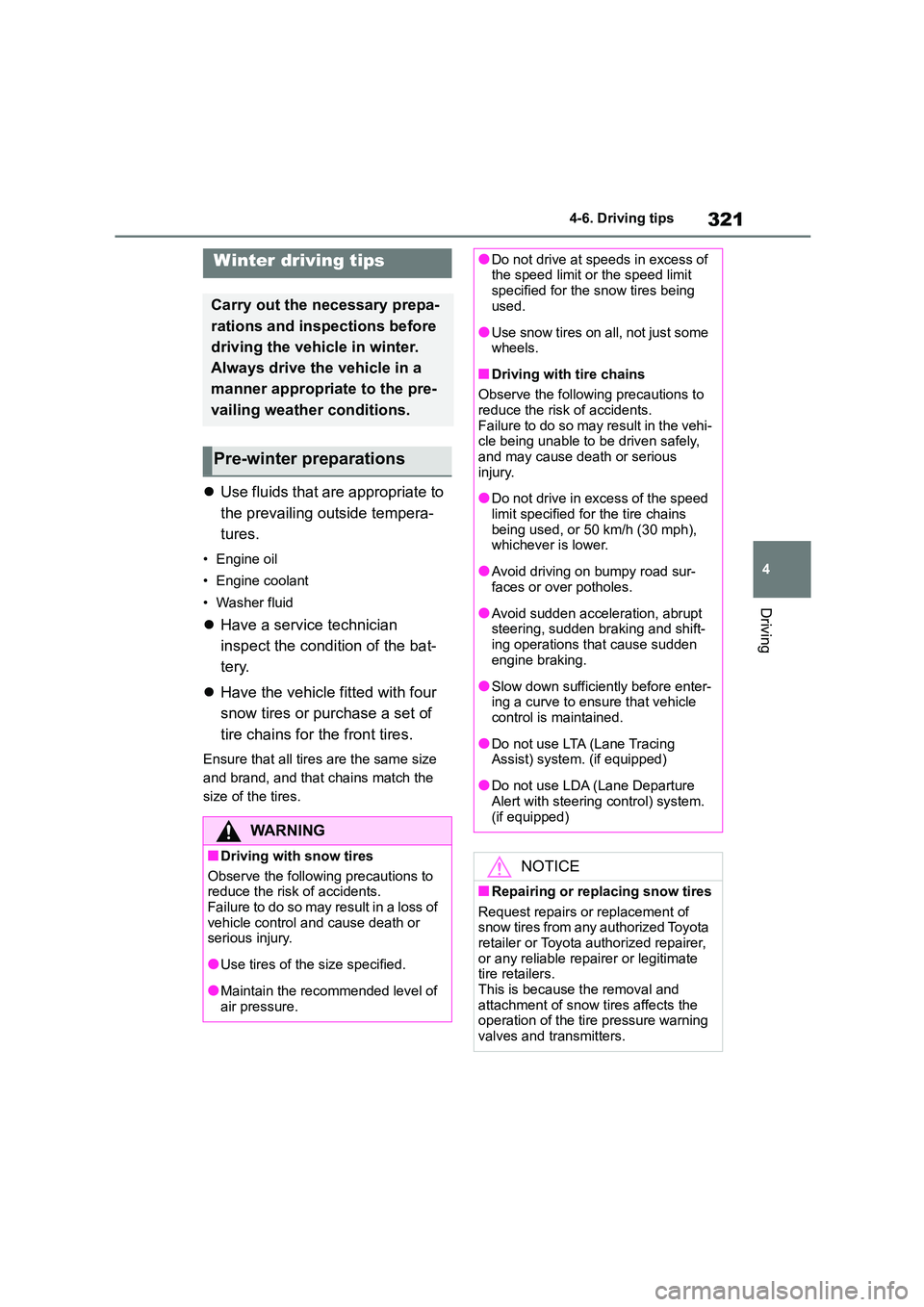
321
4
4-6. Driving tips
Driving
4-6.Driving tips
Use fluids that are appropriate to
the prevailing out side tempera-
tures.
• Engine oil
• Engine coolant
• Washer fluid
Have a service technician
inspect the condition of the bat-
tery.
Have the vehicle fitted with four
snow tires or purchase a set of
tire chains for the front tires.
Ensure that all tire s are the same size
and brand, and that chains match the
size of the tires.
Winter driving tips
Carry out the necessary prepa-
rations and inspections before
driving the vehicle in winter.
Always drive the vehicle in a
manner appropriate to the pre-
vailing weather conditions.
Pre-winter preparations
WA R N I N G
■Driving with snow tires
Observe the following precautions to
reduce the risk of accidents.
Failure to do so may result in a loss of vehicle control and cause death or
serious injury.
●Use tires of the size specified.
●Maintain the recommended level of air pressure.
●Do not drive at speeds in excess of the speed limit or the speed limit
specified for the snow tires being
used.
●Use snow tires on a ll, not just some
wheels.
■Driving with tire chains
Observe the following precautions to reduce the risk of accidents.
Failure to do so may result in the vehi-
cle being unable to be driven safely, and may cause death or serious
injury.
●Do not drive in excess of the speed
limit specified for the tire chains
being used, or 50 km/h (30 mph), whichever is lower.
●Avoid driving on bumpy road sur-faces or over potholes.
●Avoid sudden acceleration, abrupt steering, sudden braking and shift-
ing operations that cause sudden
engine braking.
●Slow down sufficiently before enter-
ing a curve to ensure that vehicle control is maintained.
●Do not use LTA (Lane Tracing Assist) system. (if equipped)
●Do not use LDA (Lane Departure Alert with steering control) system.
(if equipped)
NOTICE
■Repairing or replacing snow tires
Request repairs or replacement of snow tires from any authorized Toyota
retailer or Toyota authorized repairer,
or any reliable repairer or legitimate tire retailers.
This is because the removal and
attachment of snow tires affects the operation of the tire pressure warning
valves and transmitters.
Page 325 of 678
![TOYOTA COROLLA 2022 Owners Manual (in English) 323
4
4-6. Driving tips
Driving
Side chain (3 mm [0.12 in.] in
diameter)
Side chain (10 mm [0.39 in.] in
width)
Side chain (30 mm [1.18 in.] in
length)
Cross chain (4 mm [0.16 in.] in
diam TOYOTA COROLLA 2022 Owners Manual (in English) 323
4
4-6. Driving tips
Driving
Side chain (3 mm [0.12 in.] in
diameter)
Side chain (10 mm [0.39 in.] in
width)
Side chain (30 mm [1.18 in.] in
length)
Cross chain (4 mm [0.16 in.] in
diam](/manual-img/14/48490/w960_48490-324.png)
323
4
4-6. Driving tips
Driving
Side chain (3 mm [0.12 in.] in
diameter)
Side chain (10 mm [0.39 in.] in
width)
Side chain (30 mm [1.18 in.] in
length)
Cross chain (4 mm [0.16 in.] in
diameter)
Cross chain (14 mm [0.55 in.] in
width)
Cross chain (25 mm [0.98 in.] in
length)
Regulations regarding the use of
tire chains vary depending on loca-
tion and type of road. Always check
local regulations before installing
chains.
■Tire chain installation
Observe the following precautions when installing and removing chains:
●Install and remove tire chains in a safe location.
●Install tire chains on the front tires only. Do not install tire chains on the
rear tires.
●Install tire chains on the front tires as tightly as possible. Retighten chains
after driving 0.5 1.0 km (1/41/2
mile).
●Install tire chains following the instruc-
tions provided with the tire chains.
Regulations on the use of
tire chains
NOTICE
■Fitting tire chains
The tire pressure warning valves and
transmitters may not function cor- rectly when tire chains are fitted.
Page 430 of 678
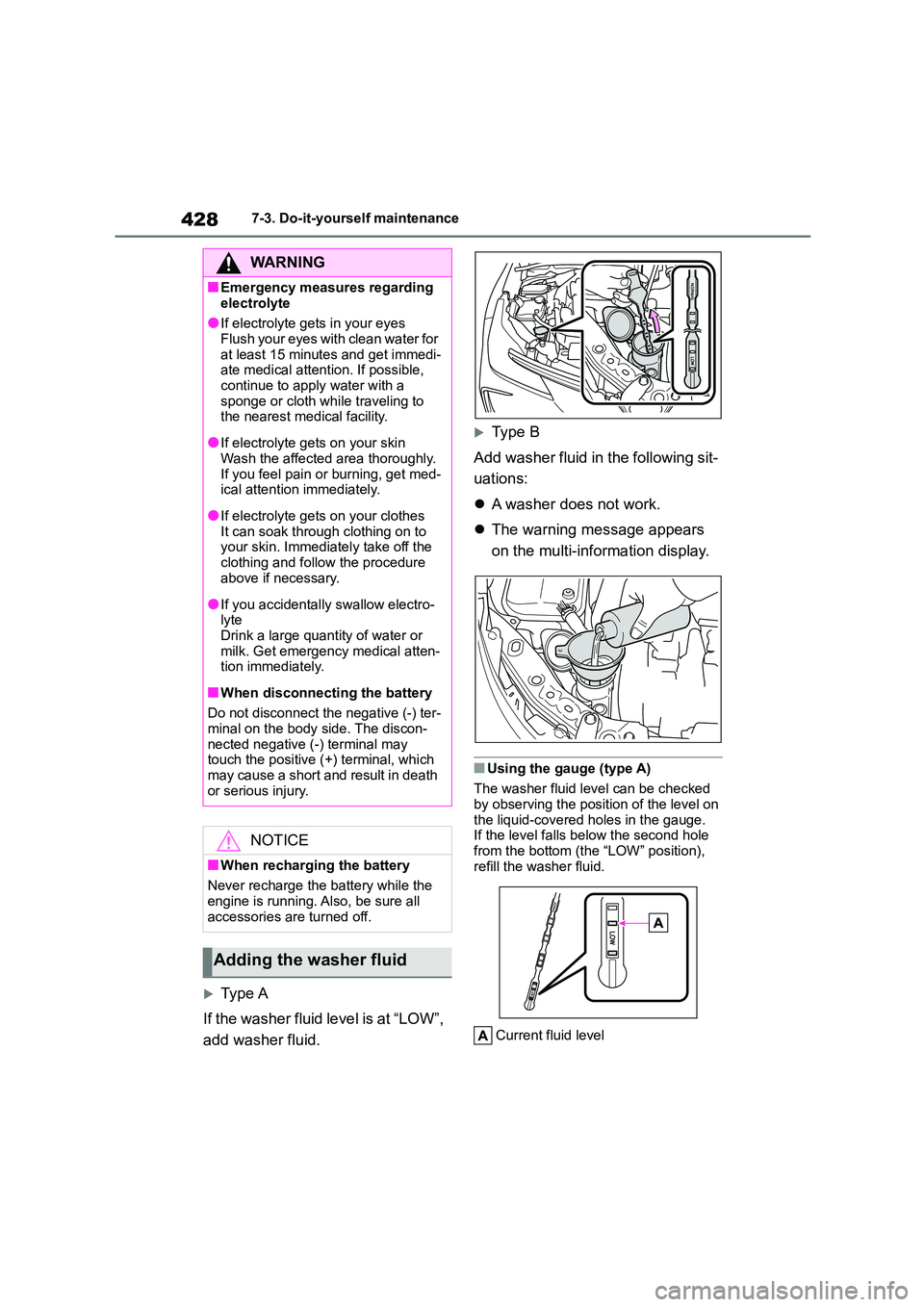
4287-3. Do-it-yourself maintenance
Type A
If the washer fluid level is at “LOW”,
add washer fluid.
Ty p e B
Add washer fluid in the following sit-
uations:
A washer does not work.
The warning message appears
on the multi-information display.
■Using the gauge (type A)
The washer fluid level can be checked
by observing the position of the level on the liquid-covered holes in the gauge.
If the level falls below the second hole
from the bottom (the “LOW” position), refill the washer fluid.
Current fluid level
WA R N I N G
■Emergency measures regarding
electrolyte
●If electrolyte gets in your eyes Flush your eyes with clean water for
at least 15 minutes and get immedi-
ate medical attention. If possible, continue to apply water with a
sponge or cloth while traveling to
the nearest medical facility.
●If electrolyte gets on your skin
Wash the affected area thoroughly.
If you feel pain or burning, get med- ical attention immediately.
●If electrolyte gets on your clothesIt can soak through clothing on to
your skin. Immediately take off the
clothing and follow the procedure above if necessary.
●If you accidentally swallow electro-lyte
Drink a large quantity of water or
milk. Get emergency medical atten- tion immediately.
■When disconnecting the battery
Do not disconnect the negative (-) ter-
minal on the body side. The discon-
nected negative (-) terminal may touch the positive (+) terminal, which
may cause a short and result in death
or serious injury.
NOTICE
■When recharging the battery
Never recharge the battery while the
engine is running. Also, be sure all
accessories are turned off.
Adding the washer fluid
Page 433 of 678
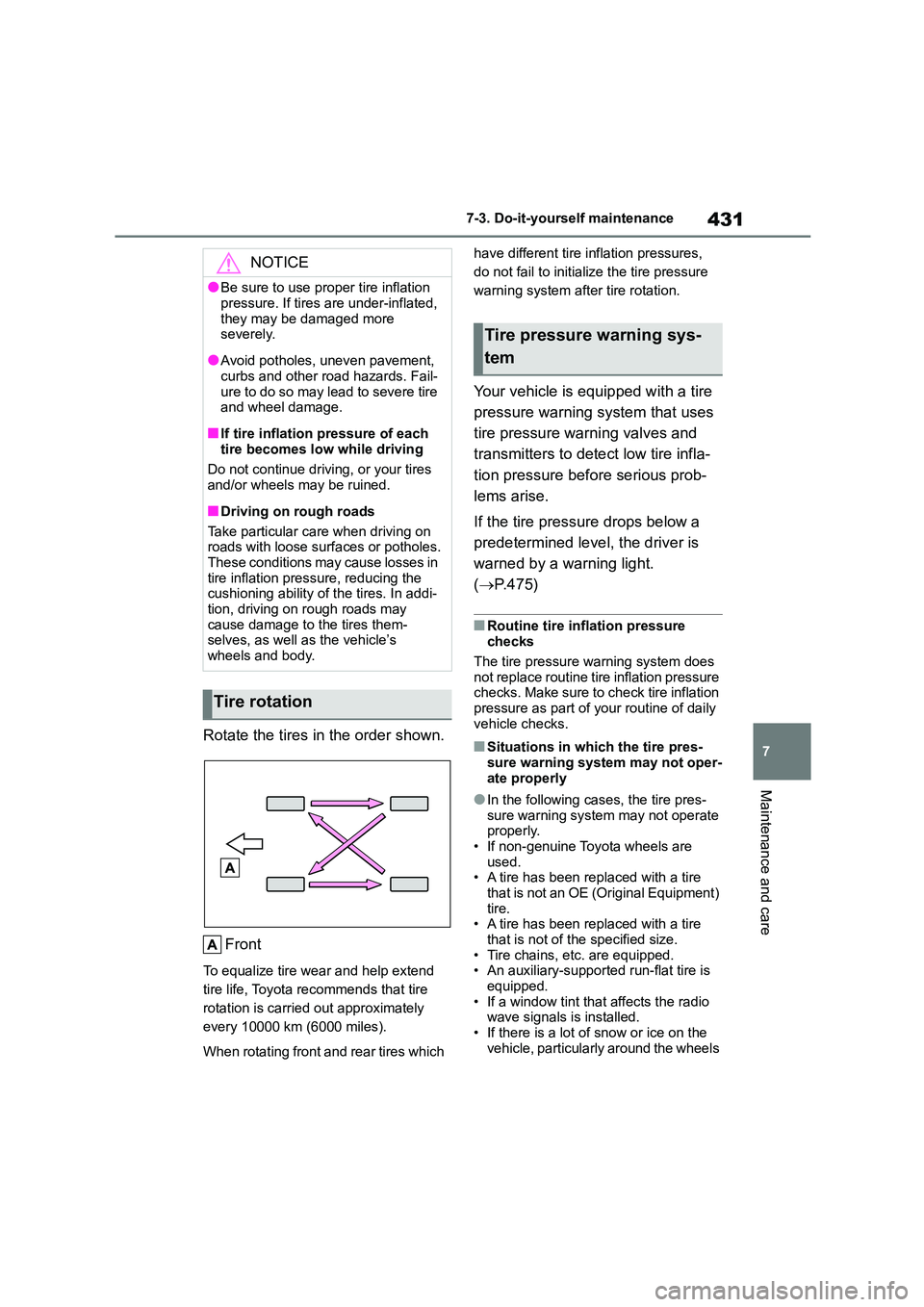
431
7
7-3. Do-it-yourself maintenance
Maintenance and care
Rotate the tires in the order shown.
Front
To equalize tire wear and help extend
tire life, Toyota recommends that tire
rotation is carried out approximately
every 10000 km (6000 miles).
When rotating front and rear tires which
have different tire inflation pressures,
do not fail to initialize the tire pressure
warning system afte r tire rotation.
Your vehicle is equipped with a tire
pressure warning system that uses
tire pressure warning valves and
transmitters to detect low tire infla-
tion pressure before serious prob-
lems arise.
If the tire pressure drops below a
predetermined level, the driver is
warned by a warning light.
( P. 4 7 5 )
■Routine tire inflation pressure
checks
The tire pressure warning system does
not replace routine tire inflation pressure
checks. Make sure to check tire inflation pressure as part of your routine of daily
vehicle checks.
■Situations in which the tire pres-
sure warning system may not oper-
ate properly
●In the following cases, the tire pres-
sure warning system may not operate properly.
• If non-genuine Toyota wheels are
used. • A tire has been replaced with a tire
that is not an OE (Original Equipment)
tire. • A tire has been replaced with a tire
that is not of the specified size.
• Tire chains, etc. are equipped. • An auxiliary-supported run-flat tire is
equipped.
• If a window tint that affects the radio wave signals is installed.
• If there is a lot of snow or ice on the
vehicle, particularly around the wheels
NOTICE
●Be sure to use proper tire inflation
pressure. If tires are under-inflated,
they may be damaged more severely.
●Avoid potholes, uneven pavement, curbs and other road hazards. Fail-
ure to do so may lead to severe tire
and wheel damage.
■If tire inflation pressure of each
tire becomes low while driving
Do not continue driving, or your tires and/or wheels may be ruined.
■Driving on rough roads
Take particular care when driving on
roads with loose surfaces or potholes.
These conditions may cause losses in tire inflation pressure, reducing the
cushioning ability of the tires. In addi-
tion, driving on rough roads may cause damage to the tires them-
selves, as well as the vehicle’s
wheels and body.
Tire rotation
Tire pressure warning sys-
tem
Page 434 of 678
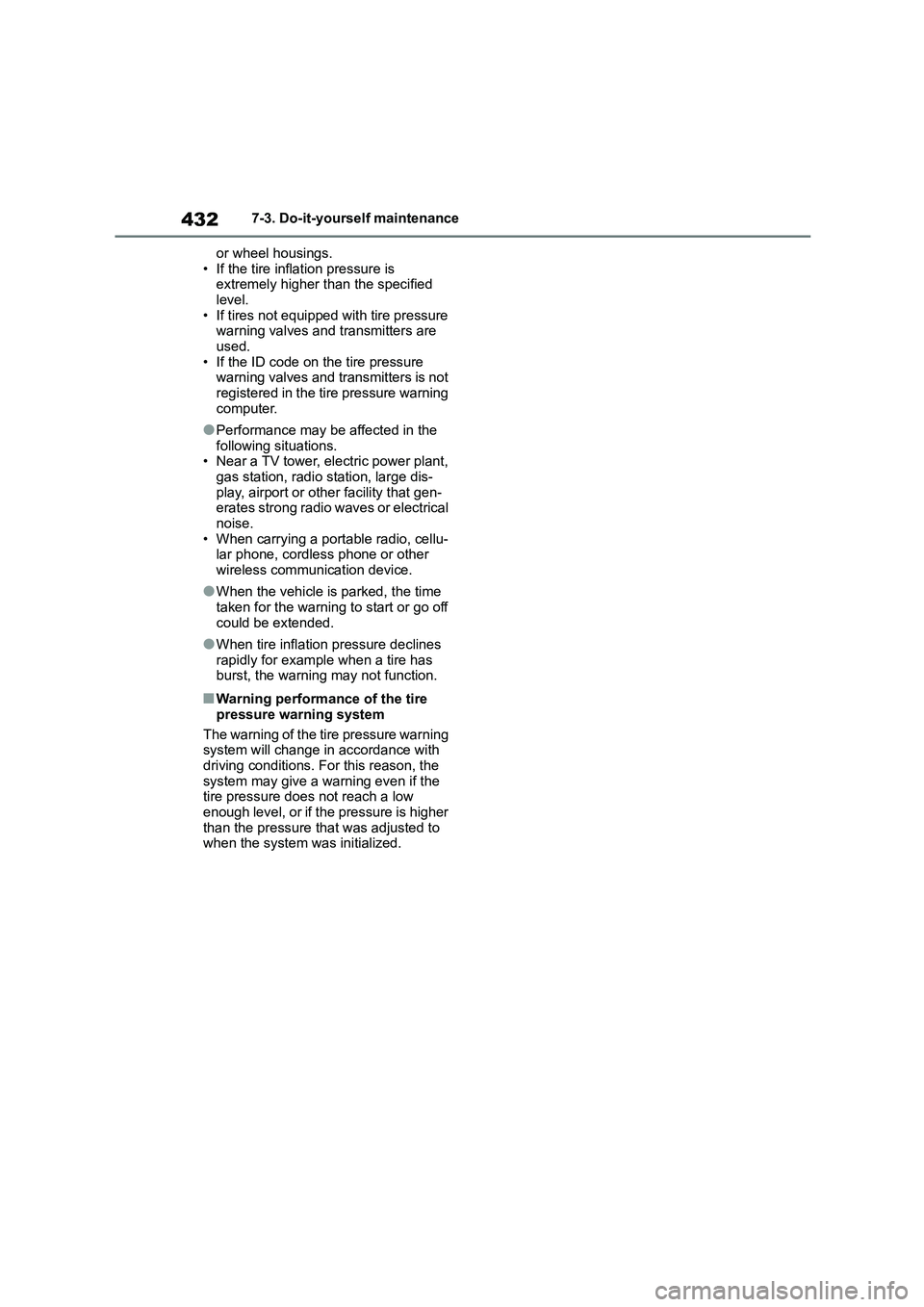
4327-3. Do-it-yourself maintenance
or wheel housings.
• If the tire inflation pressure is extremely higher than the specified
level.
• If tires not equipped with tire pressure warning valves and transmitters are
used.
• If the ID code on the tire pressure warning valves and transmitters is not
registered in the tire pressure warning
computer.
●Performance may be affected in the
following situations. • Near a TV tower, electric power plant,
gas station, radio station, large dis-
play, airport or other facility that gen- erates strong radio waves or electrical
noise.
• When carrying a portable radio, cellu- lar phone, cordless phone or other
wireless communication device.
●When the vehicle is parked, the time
taken for the warning to start or go off
could be extended.
●When tire inflation pressure declines
rapidly for example when a tire has burst, the warning may not function.
■Warning performance of the tire
pressure warning system
The warning of the tire pressure warning system will change in accordance with
driving conditions. For this reason, the
system may give a warning even if the tire pressure does not reach a low
enough level, or if the pressure is higher
than the pressure th at was adjusted to when the system was initialized.